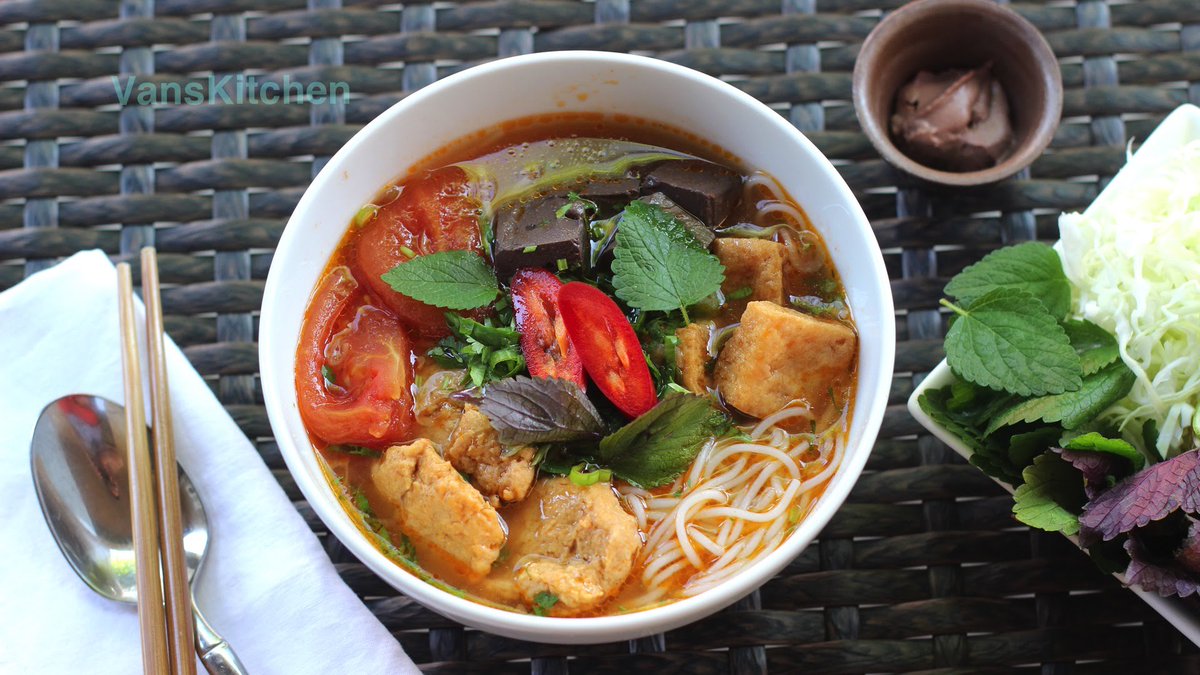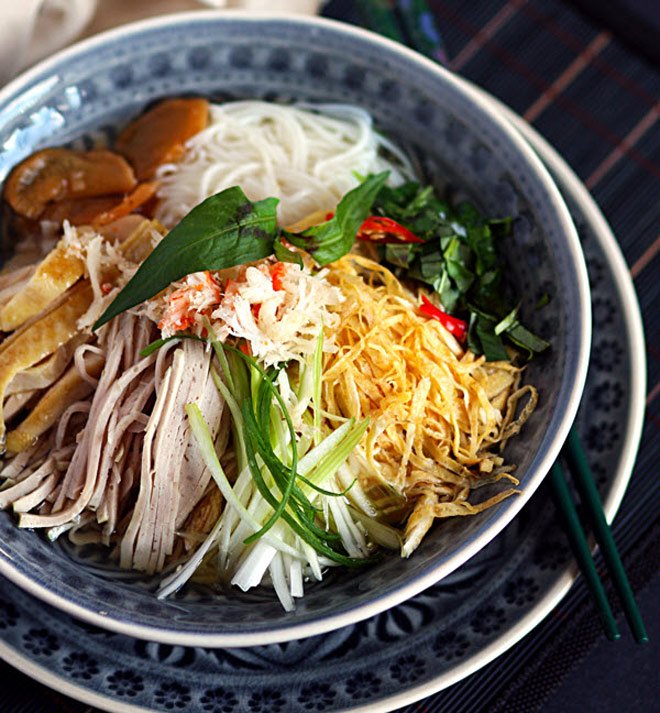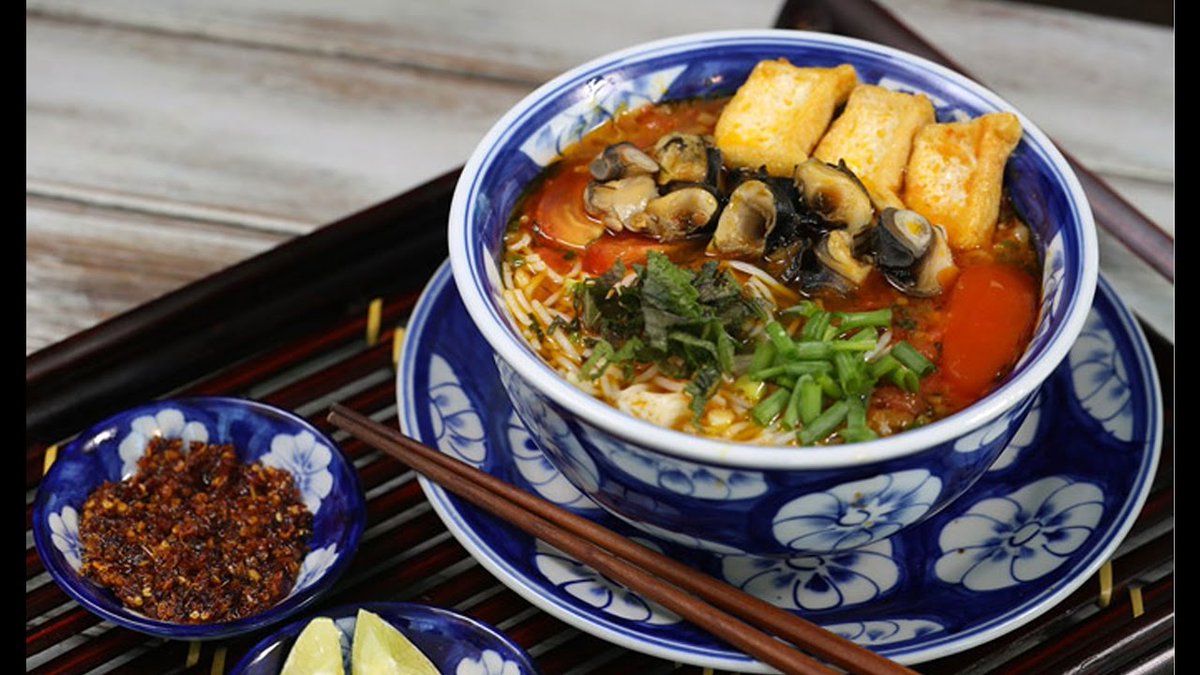E
Edmund
Thành viên mới
It is a fact that pho is at the heart of Vietnam cuisine and dominates the itinerary of all Hoian food tours. However, pho is not always the first choice of locals when it comes to street food. Like Italy and pizza, Hanoi has a strong connection with bun that not many travelers realize. Here are a few signature bun dishes to further extend your food experience in Hanoi:
Bun rieu
No bun variety can be as popular yet simple as bun rieu cua; it is also a perfect start in any Vietnam food tour(Vietnam foods---->https://www.hellovietnam.com/tour/hanoi-foodie-tour-116.html). Every bun rieu cua starts with the bowl. To serve, hot crab stock is ladled onto the waiting blanched vermicelli noodles. Each bowl of bun rieu cua is accompanied by a heap of herbs. The usual companion of bun rieu cua are banana stem, shiso, helancha, and coriander. Salt and chili but not pepper are used to add some more flavors to the bowl.

A bowl of bun rieu cua is a perfect balance of spices. The savory taste comes from crab butter and the tart-sweet flavor is contributed by tomato wedges. The most authentic sourness can only be achieved by adding fermented cooked rice or wine vinegar; qua doc (Garcinia multiflora fruit), star fruit, or tamarind can be substitutes but the taste will be slightly altered.
Bun cha
There aren’t many types of smoke that are soothing and can trigger your appetite like the way that of bun cha does. And why all the bun cha vendors char-grill the meat despite the popularity of electric ovens you ask?. The answer here is that the coal will add the iconic smoky flavor to the meat patties. There are two options when it comes to bun cha’s meat, flat pork patties with fine chopped onion included and slices of pork belly, both are grilled until crispy-edged and put into the dipping sauce bowl so that they can absorb part of the flavors.

Bun cha’s quality relies on the dipping sauce and the meat. The winning tip here is the balance. Fish sauce, sugar, vinegar, and chili follow a strict rule that no flavor is allowed to be dominant over others. The greens are there to make a contrast to the meat.
Bun thang
This used to be an unaffordable luxury catering to the elite in Hanoi.Bun thang broth is made by brewing pork, chicken, and prawns, an ideal warming dish for winter.

There are five types of meat in bun thang, enough to cover the whole surface of the bowl. Egg omelette, gio lua, chicken, and prawn are arranged after the noodle. The greens of bun thang are Vietnamese coriander, spring onion, and regular coriander. A bowl of bun thang cannot be complete without some belostomatidae essence and mam tom (fermented shrimp paste). Don’t let the pungent smell of mam tom drives you away, the flavorful stock will totally cover it.
Bun oc
To be clear, oc here means snails, the large pried out of cavernous shells, chewy and slimy kind of snail. The base of bun oc is not much different from that of bun rieu cua; tart-sweetness is imparted by tomato wedges, sourness is from wine vinegar and mam tom adds an indefinable depth of flavor.

In Vietnam, it is very important that the food is beautifully presented. The dish is embellished by the natural colors of herbs, tofu cubes, and tomato. As tofu’s biggest selling point is its bland taste, it is there to absorb the flavorful broth. Oc nhoi (a large edible snail) and escargot are used frequently in bun oc, black snail is used too when the those two become too expensive or rare.
You can see anything at "Việt Nam" in hellovietnam company: hellovietnam.com <===Website!
Bun rieu
No bun variety can be as popular yet simple as bun rieu cua; it is also a perfect start in any Vietnam food tour(Vietnam foods---->https://www.hellovietnam.com/tour/hanoi-foodie-tour-116.html). Every bun rieu cua starts with the bowl. To serve, hot crab stock is ladled onto the waiting blanched vermicelli noodles. Each bowl of bun rieu cua is accompanied by a heap of herbs. The usual companion of bun rieu cua are banana stem, shiso, helancha, and coriander. Salt and chili but not pepper are used to add some more flavors to the bowl.

A bowl of bun rieu cua is a perfect balance of spices. The savory taste comes from crab butter and the tart-sweet flavor is contributed by tomato wedges. The most authentic sourness can only be achieved by adding fermented cooked rice or wine vinegar; qua doc (Garcinia multiflora fruit), star fruit, or tamarind can be substitutes but the taste will be slightly altered.
Bun cha
There aren’t many types of smoke that are soothing and can trigger your appetite like the way that of bun cha does. And why all the bun cha vendors char-grill the meat despite the popularity of electric ovens you ask?. The answer here is that the coal will add the iconic smoky flavor to the meat patties. There are two options when it comes to bun cha’s meat, flat pork patties with fine chopped onion included and slices of pork belly, both are grilled until crispy-edged and put into the dipping sauce bowl so that they can absorb part of the flavors.

Bun cha’s quality relies on the dipping sauce and the meat. The winning tip here is the balance. Fish sauce, sugar, vinegar, and chili follow a strict rule that no flavor is allowed to be dominant over others. The greens are there to make a contrast to the meat.
Bun thang
This used to be an unaffordable luxury catering to the elite in Hanoi.Bun thang broth is made by brewing pork, chicken, and prawns, an ideal warming dish for winter.

There are five types of meat in bun thang, enough to cover the whole surface of the bowl. Egg omelette, gio lua, chicken, and prawn are arranged after the noodle. The greens of bun thang are Vietnamese coriander, spring onion, and regular coriander. A bowl of bun thang cannot be complete without some belostomatidae essence and mam tom (fermented shrimp paste). Don’t let the pungent smell of mam tom drives you away, the flavorful stock will totally cover it.
Bun oc
To be clear, oc here means snails, the large pried out of cavernous shells, chewy and slimy kind of snail. The base of bun oc is not much different from that of bun rieu cua; tart-sweetness is imparted by tomato wedges, sourness is from wine vinegar and mam tom adds an indefinable depth of flavor.

In Vietnam, it is very important that the food is beautifully presented. The dish is embellished by the natural colors of herbs, tofu cubes, and tomato. As tofu’s biggest selling point is its bland taste, it is there to absorb the flavorful broth. Oc nhoi (a large edible snail) and escargot are used frequently in bun oc, black snail is used too when the those two become too expensive or rare.
You can see anything at "Việt Nam" in hellovietnam company: hellovietnam.com <===Website!
